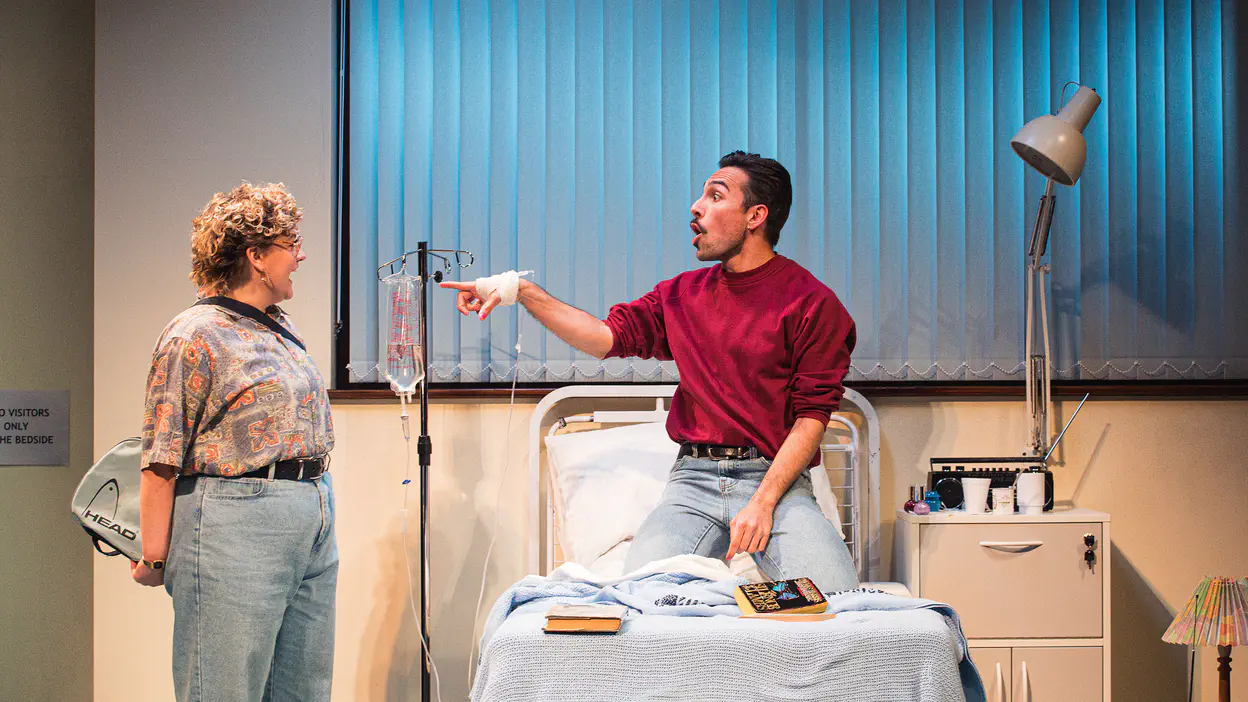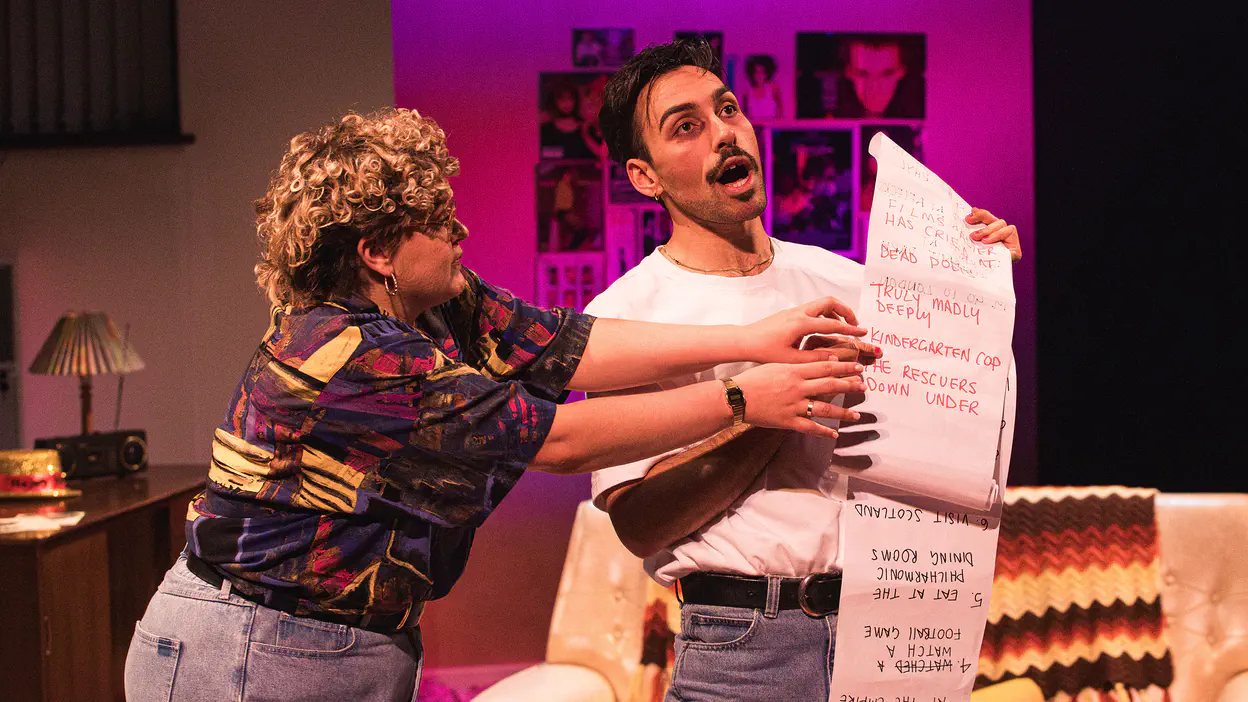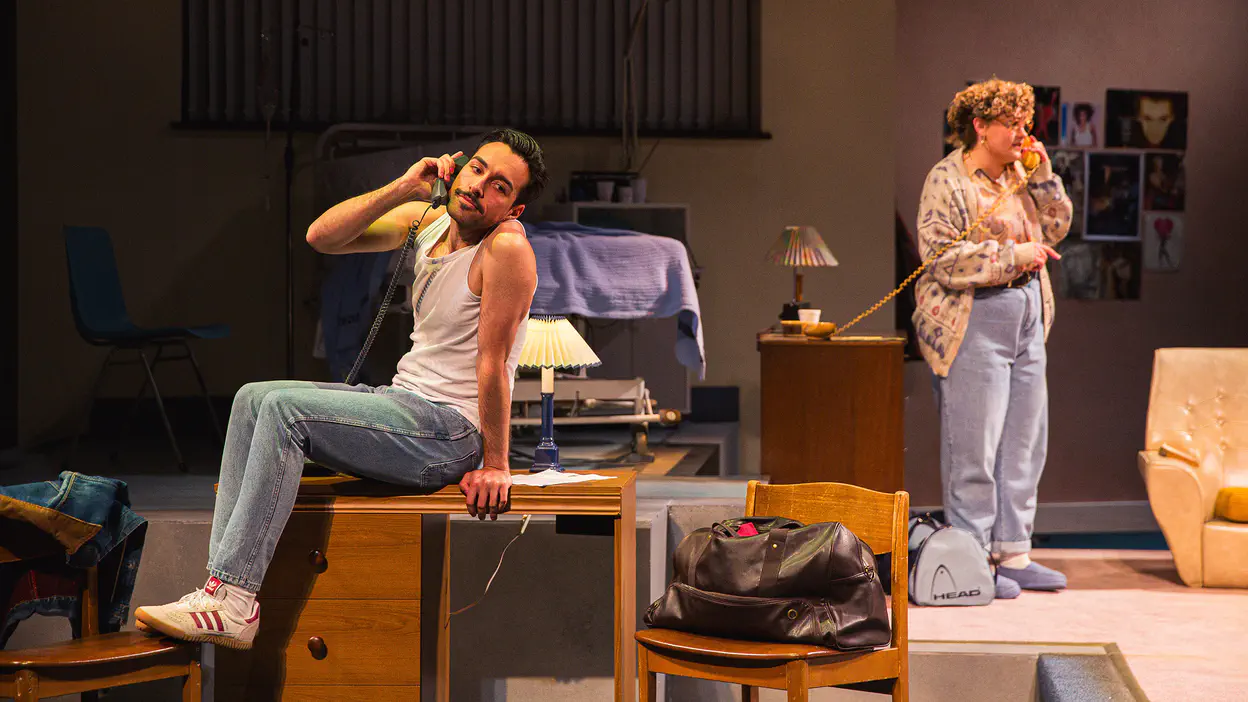Tell Me How It Ends
Liverpool Everyman Theatre

The 1980s, a time of big hair and even bigger shoulder pads, the emergence of MTV, and when an epidemic brought with it prejudice, fear, and new attitudes around being queer. In hospital rooms across the country, and indeed the world, groups of lesbians were ensuring that gay men diagnosed with HIV/AIDS were not forgotten or left to suffer alone. Many families turned their backs on their loved ones out of fear, but the lesbian community stepped up to support a part of society that many had marginalized.
Tell Me How It Ends is a new play by Tasha Dowd focussing on this time. The play tells the story of Marc (Luke Sookdeo), a gay man with AIDS, and Aster (Emmy Stonelake) an overly optimistic lesbian who has a habit of spoiling the ending of books.
Aster volunteers at the local hospital where Marc is being treated. Despite being polar opposites, Aster is determined to help Marc, even if that means just bringing in yogurt without the bits and sitting in the corner reading her book. As the two start to bond, they create a friendship and memories to last a lifetime in an uncertain future.

Tell Me How It Ends is quite simply incredible. Tasha Dowd has created a truly moving piece of theatre through writing that is powerful, poignant, and extremely accomplished. They effortlessly blend humour with heavy, heartfelt moments that had the audience in tears.
While Marc and Aster’s individual story is always at the forefront, the wider commentary on the global stigma of HIV and AIDS is never shied away from, or presented with a revisionist attitude. The authenticity of the piece is undoubtedly one of the reasons why the audience connected so deeply with it.
The most powerful part of the play was the ending. Aster consistently reveals the ending of books throughout the play, but nobody could fail to guess the ending of Tell Me How It Ends. But amongst the sadness and beauty in Marc succumbing to the illness is an authoritative call to arms. Charged with anger, the audience is reminded not to grow complacent, that battles still exist (particularly within trans rights), and that protesting is important to ensure all voices are heard. An empowered and highly charged end to the story that few were expecting.
Tell Me How It Ends is a two-hander, and the performances by (Emmy Stonelake) and (Luke Sookdeo) were enthralling.
From the moment Marc and Aster appeared on stage, Stonelake and Sookdeo balanced their respective characters’ vulnerability, stubbornness, and sincerity perfectly. The intricacies of their feelings towards one another were often communicated with a look or a smile which added to the chemistry, whilst seemingly irrelevant details helped to grow the connection between the audience, such as when Marc was mocking Aster for crying at The Rescuers Down Under.

This production was (Luke Sookdeo’s) professional debut, but he delivered a detailed and nuanced performance with confidence that showcased he is a talented actor and a rising star. (Emmy Stonelake) emanated a natural warmth and anchored the play, delivering many of the comedic moments without taking away from the subject matter or overshadowing the highly emotional elements; a very assured performance by an incredibly talented actor.
Gitika Buttoo’s direction should also be noted for its delivery of an incredible chemistry between Marc and Aster, as should the set design by Katie Scott.
The Everyman Theatre has a Thrust Stage which was used to great effect, with Gitika Buttoo not being afraid of the cast having their backs to some or all of the audience for certain scenes. The effect was almost like an episode of Big Brother where the audience was watching events unfold, rather than being performed to.
The staging is simple yet incredibly effective. Individual areas denote the different spaces in Marc and Aster’s lives; the hospital room, Aster’s home, Marc’s bedsit, and even a nightclub. The sets are split across different levels creating an organic flow of movement, but also allowing the audience to simultaneously experience each character’s lives when they aren’t together. Additionally, the multi-level staging of the sets provided powerful symbolism throughout the play. The hospital bed was at the upper level and forever present, much like Marc’s AIDS.

The lighting on stage designed by Jack Coleman also mimicked the different set areas. The hospital room was given a stark, white, coloured light whereas Aster’s flat had a warmer, yellow, light that came from a pendant lampshade. The lighting differences helped to differentiate the staging without the need for walls to separate each space. This really brought home the difference between the clinical hospital setting and the warmth of Aster’s friendship.
This is an emotionally charged piece of theatre that serves as a stark reminder to those who lived through the period and provides an educational lesson to those who didn’t. There wasn’t a dry eye left in the house after the play, which is a testament to how impactful this is. We thoroughly enjoyed this production, and would highly recommend watching this show.
Tell Me How It Ends is on at the Liverpool Everyman until 22 June 2024. Tickets start at £11. As books feature so heavily in the production, the Everyman is also running a book swap for the duration of the play. Simply take a book with a brief synopsis (no spoilers!), and swap for one wrapped up.
Originally posted: